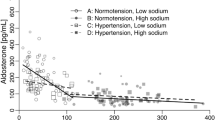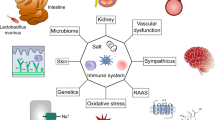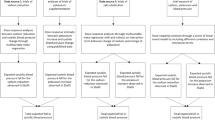Abstract
Excessive salt intake exacerbates hypertension and further increases left-ventricular mass in clinical essential and experimental hypertension. Additionally, a growing body of evidence strongly suggests that high dietary salt loading exerts detrimental cardiac effects independently of its hemodynamic load. The clinical evidence of cardiac structural and functional alterations associated with salt is, however, scarce. In order to explore the purported beliefs in humans, in this review we draw on our experimental studies in naturally occurring hypertension and discuss the clinical implications of the nonhemodynamic mechanisms underlying these salt-related changes.
This is a preview of subscription content, access via your institution
Access options
Subscribe to this journal
Receive 12 print issues and online access
$209.00 per year
only $17.42 per issue
Buy this article
- Purchase on Springer Link
- Instant access to full article PDF
Prices may be subject to local taxes which are calculated during checkout




Similar content being viewed by others
References
Elliott P et al. (1996) Intersalt revisited: further analysis of 24 hour sodium excretion and blood pressure within and across populations: Intersalt Cooperative Research Group. BMJ 312: 1249–1253
Stamler J (1997) The Intersalt Study: background, methods, findings, and implications. Am J Clin Nutr 65 (suppl): 626–642
Sacks FM et al. for the DASH-Sodium Collaborative Research Group (2001) Effects on blood pressure of reduced dietary sodium and the Dietary Approaches to Stop Hypertension (DASH) diet. N Engl J Med 344: 3–10
Whelton PK et al. (1998) Sodium reduction and weight loss in the treatment of hypertension in older persons: a randomized controlled trial of nonpharmacologic interventions in the elderly (TONE): TONE Collaborative Research Group. JAMA 279: 839–846
Frohlich ED (1999) Risk mechanisms in hypertensive heart disease. Hypertension 34: 782–789
Frohlich ED et al. (1992) The heart in hypertension. N Engl J Med 327: 998–1008
Frohlich ED and Re R (1998) Pathophysiology of systemic arterial hypertension. In Hurst's The Heart, 1635–1650 (Eds, Schlant RC et al.) New York: McGraw-Hill
Frohlich ED et al. (1993) Relationship between dietary sodium intake, hemodynamics, and cardiac mass in SHR and WKY rats. Am J Physiol 264: R30–34
Yu HC et al. (1998) Salt induces myocardial and renal fibrosis in normotensive and hypertensive rats. Circulation 98: 2621–2628
Leenen FHH and Yuan B (1998) Dietary-sodium-induced cardiac remodeling in spontaneously hypertensive rat versus Wistar-Kyoto rat. J Hypertens 16: 885–892
du Cailar G et al. (2002) Dietary sodium and target organ damage in essential hypertension. Am J Hypertens 15: 222–229
He J et al. (1999) Dietary sodium intake and subsequent risk of cardiovascular disease in overweight adults. JAMA 282: 2027–2034
Tuomilehto J et al. (2001) Urinary sodium excretion and cardiovascular mortality in Finland: a prospective study. Lancet 357: 848–851
Tunstall-Pedoe H et al. (1997) Comparison of the prediction by 27 different factors of coronary heart disease and death in men and women of the Scottish heart health study: cohort study. BMJ 315: 722–729
Chrysant SG et al. (1979) Hemodynamic and metabolic evidence of salt sensitivity in spontaneously hypertensive rats. Kidney Int 15: 33–37
Lindpaintner K and Sen S (1985) Role of sodium in hypertensive cardiac hypertrophy. Circ Res 57: 610–617
du Cailar G et al. (1989) Influence of sodium intake on left ventricular structure in untreated essential hypertensives. J Hypertens 7: S258–S259
Fields NG et al. (1991) Sodium-induced cardiac hypertrophy: cardiac sympathetic activity versus volume load. Circ Res 68: 745–755
du Cailar G et al. (1992) Sodium and left ventricular mass in untreated hypertensive and normotensive subjects. Am J Physiol 263: H177–H181
de la Sierra A et al. (1996) Increased left ventricular mass in salt-sensitive hypertensive patients. J Hum Hypertens 10: 795–799
Ahn J et al. (2004) Cardiac structural and functional responses to salt loading in SHR. Am J Physiol 287: H767–H772
Meggs LG et al. (1988) Myocardial hypertrophy: the effect of sodium and the role of sympathetic nervous system activity. Am J Hypertens 1: 11–15
Liebson PR et al. (1995) Comparison of five antihypertensive monotherapies and placebo for change in left ventricular mass in patients receiving nutritional-hygienic therapy in the Treatment of Mild Hypertension Study (TOMHS). Circulation 91: 698–706
Querejeta R et al. (2000) Serum carboxy-terminal propeptide of procollagen type I is marker of myocardial fibrosis in hypertensive heart disease. Circulation 101: 1729–1735
Kyselovic J et al. (1998) Prevention of salt-dependent cardiac remodeling and enhanced gene expression in stroke-prone hypertensive rats by the long-acting calcium channel blocker lacidipine. J Hypertens 16: 1515–1522
Musiari L et al. (1999) Early abnormalities in left ventricular diastolic function of sodium-sensitive hypertensive patients. J Hum Hypertens 13: 711–716.
Langenfeld MR et al. (1998) Impact of dietary sodium intake on left ventricular diastolic filling in early essential hypertension. Eur Heart J 19: 951–958
Brilla CG et al. (1991) Impaired diastolic function and coronary reserve in genetic hypertension: role of interstitial fibrosis and medial thickening of intramyocardial coronary arteries. Circ Res 69: 107–115
Susic D et al. (1998) Coronary hemodynamics in aging spontaneously hypertensive and normotensive Wistar-Kyoto rats. J Hypertens 16: 231–237
Brilla CG et al. (2000) Lisinopril-mediated regression of myocardial fibrosis in patients with hypertensive heart disease. Circulation 102: 1388–1393
Schwartzkopff B et al. (2000) Repair of coronary arterioles after treatment with perindopril in hypertensive heart disease. Hypertension 36: 220–225
Pomeranz A et al. (2002) Increased sodium concentration in drinking water increase blood pressure in neonates. J Hypertens 20: 203–207
Yuan B and Leenen FHH (1991) Dietary sodium intake and left ventricular hypertrophy in normotensive rats. Am J Physiol 261: H1397–H1401
Sen S and Young DR (1986) Role of sodium in modulation of myocardial hypertrophy in renal hypertensive rats. Hypertension 8: 918–924
Skrabal F et al. (1981) Low sodium/high potassium diet for prevention of hypertension: possible mechanisms of action. Lancet 2: 895–900
Limas C and Limas CJ (1985) Cardiac beta-adrenergic receptors in salt-dependent genetic hypertension. Hypertension 7: 760–766
MacPhee AA et al. (1980) Altered cardiac beta-adrenoreceptors in spontaneously hypertensive rats receiving salt excess. Clin Sci 59: 169s–170s
Partovian C et al. (1998) Effects of a chronic high-salt diet on large artery structure: role of endogenous bradykinin. Am J Physiol 274: H1423–1428
Nicholls MG et al. (1980). Plasma norepinephrine variations with dietary sodium intake. Hypertension 2: 29–32
Grassi G et al. (2002) Short- and long-term neuroadrenergic effects of moderate dietary sodium restriction in essential hypertension. Circulation 106: 1957–1961
Alderman MH et al. (1995) Low urinary sodium is associated with greater risk of myocardial infarction among treated hypertensive men. Hypertension 25: 1144–1152
Alderman MH et al. (1998) Dietary sodium intake and mortality; the National Health and Nutrition Examination Survey (NHANES 1). Lancet 351: 781–785
de Wardener HE (1999) Salt reduction and cardiovascular risk: the anatomy of a myth. J Hum Hypertens 13: 1–4
Kumanyika SK and Cutler JA (1997) Dietary sodium reduction: is there cause for concern? J Am Coll Nutr 16: 192–203
Schmieder RA et al. (1996) Angiotensin II related to sodium excretion modulates left ventricular structure in human essential patients. Circulation 94: 1304–1309
de la Sierra A et al. (1996) Fluid, ionic and hormonal changes induced by high salt intake in salt-sensitive and salt-resistant hypertensive patients. Clin Sci 91: 155–161
Hodge G et al. (2002) Dysregulation of angiotensin II is associated with salt sensitivity in the spontaneous hypertensive rat. Acta Physiol Scand 174: 209–215
Takeda Y et al. (2001) Effects of high sodium intake on cardiovascular aldosterone synthesis in stroke-prone spontaneously hypertensive rats. J Hypertens 19: 635–639
Feron O et al. (1995) Influence of salt loading on the cardiac and renal preproendothelin-1 mRNA expression in stroke-prone spontaneously hypertensive rats. Biochem Biophys Res Commun 209: 161–166
Gu J-W et al. (1998) Sodium induces hypertrophy of cultured myocardial myoblasts and vascular smooth muscle cells. Hypertension 31: 1083–108755
Author information
Authors and Affiliations
Corresponding author
Ethics declarations
Competing interests
The authors declare no competing financial interests.
Rights and permissions
About this article
Cite this article
Frohlich, E., Varagic, J. The role of sodium in hypertension is more complex than simply elevating arterial pressure. Nat Rev Cardiol 1, 24–30 (2004). https://doi.org/10.1038/ncpcardio0025
Received:
Accepted:
Issue Date:
DOI: https://doi.org/10.1038/ncpcardio0025
This article is cited by
-
The Correlation Between Urinary Sodium Excretion and Blood Pressure in Hospitalized Adult Patients with Hypertension
Advances in Therapy (2021)
-
ACALYPHA WILKESIANA regulates fluid volume but affects selected tissues in salt loaded rabbits
Clinical Phytoscience (2019)
-
Strategies to Reduce Dietary Sodium Intake
Current Treatment Options in Cardiovascular Medicine (2012)
-
The role of salt in hypertension: the complexity seems to become clearer
Nature Clinical Practice Cardiovascular Medicine (2008)
-
The aging hypertensive heart: a brief update
Nature Clinical Practice Cardiovascular Medicine (2008)



